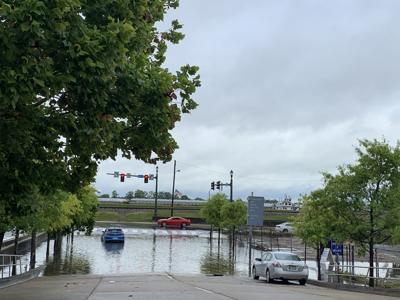Local, state and federal officials announced Wednesday they had come up with a way to complete a long-discussed but never-funded plan to dredge and widen 66 miles of waterways and reduce the flooding risk along five main drainage canals in East Baton Rouge Parish.
The state of Louisiana and the cities of Baton Rouge and Central will supply about $65 million in local matching funds necessary to tap federal dollars for the $225 million U.S. Army Corps of Engineers project. The work will begin next year and take four years to complete.
Mayor-President Sharon Weston Broome announced Gov. John Bel Edwards has committed $40 million in upfront matching funds, and the state will also provide half of the matching money needed over the longer term.
The city-parish will likely finance about $8.5 million of the remaining $12.5 million needed, and the city of Central will dip into its budget surplus to provide $4 million.
Most members of the Metro Council whom The Advocate spoke with Wednesday didn’t express any immediate opposition to the administration’s plans, but nearly all said they would first need to review the particulars before committing their full support.
Broome will ask the council members for final approval on the city-parish’s agreement with the state and Corps of Engineers when they meet next week.
"I'm proud to announce help is indeed on the way," Broome said at a news conference Wednesday with the governor and U.S. Rep. Garret Graves. “We now have a path forward to solve one of our biggest drainage challenges.”
The parish’s Flood Risk Reduction Project will involve dredging, widening and upgrading portions of Bayou Fountain, Beaver Bayou, Blackwater Bayou, Jones Creek and Ward Creek.
Catastrophic floods in August 2016 renewed interest in the flood-control project. Backwater flooding inundated many portions of East Baton Rouge three years ago and a number of flash floods following torrential downpours have caused additional damage.
The most recent bout of flash flooding occurred June 6 in East Baton Rouge Parish, resulting in the death of one person and flooding of nearly 200 buildings and more than 100 vehicles.
“We cannot sustain additional floods like that in our community,” Graves said. “We can’t afford it. Folks can’t go through the mental stress of it. This (project) means you’ll be safer.”
Graves revealed the city-parish had been at risk of losing the federal funds for the project because the local administration couldn’t come up with the matching funds.
“Everyone came together and put our differences to the side and said we’d figure this out,” said Graves, a Republican from Baton Rouge.
The governor said the state is looking at several funding options for the $52.5 million in total matching funds he has committed to the city-parish. Some of the money will be found in the state’s capital outlay and surplus funds. He also intends to ask the state’s Interim Emergency Board to reauthorize some funding that had been earmarked for the Comite River Diversion Canal Project, which is now fully funded with federal dollars.
“We have various ways to meet our obligation,” Edwards said.
The governor said there’s flexibility since allocation of the matching funds can be spread out over the four-year construction phase.
Two the five drainage canals pass through the city of Central, most of which was swamped during the 2016 floods.
Central Mayor David Barrow said the City Council was in unanimous support of dipping into its surplus to provide the $4 million they’ve committed to the city-parish.
“When you have something this good that will produce a lot of benefits for a vast majority of citizens, it’s well worth it,” Barrow said.
East Baton Rouge Metro Councilwoman Barbara Freiberg called the project “critical” and thanked the governor and the state for stepping up in a much-needed way.
Councilman Matt Watson echoed those sentiments, saying the state is “bailing the administration out” by providing the local matching funds which Graves worked hard to secure in Congress.
“I support anything that helps remediate our parish’s drainage problems,” he said.
Broome also said Wednesday the city-parish is seeking federal approval for 25 hazard mitigation projects, some of which might include other drainage work.
Fred Raiford, the city-parish’s director of transportation and drainage, said the clearing and snagging along the five canals is a major first step in the parish’s holistic approach toward addressed its parishwide drainage issues.
He said the city-parish will also be in conversations with the state’s Office of Community Development regarding its watershed initiative to ensure none of the city-parish’s flood mitigation efforts adversely affects surrounding parishes.
“The goal is to enhance our (water) flow without creating any problems downstream,” he said.












